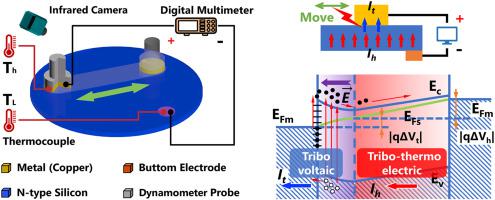当前位置:
X-MOL 学术
›
Mater. Today Phys.
›
论文详情
Our official English website, www.x-mol.net, welcomes your
feedback! (Note: you will need to create a separate account there.)
Tribo-thermoelectric and tribovoltaic coupling effect at metal-semiconductor interface
Materials Today Physics ( IF 10.0 ) Pub Date : 2021-01-01 , DOI: 10.1016/j.mtphys.2020.100295 Zhi Zhang , Tianlong He , Junqing Zhao , Guoxu Liu , Zhong Lin Wang , Chi Zhang
Materials Today Physics ( IF 10.0 ) Pub Date : 2021-01-01 , DOI: 10.1016/j.mtphys.2020.100295 Zhi Zhang , Tianlong He , Junqing Zhao , Guoxu Liu , Zhong Lin Wang , Chi Zhang

|
Abstract Frictional heating and triboelectrification are ancient and common physical phenomena. Fricting at a semiconductor interface has brought new tribovoltaic effect, while the frictional heating on semiconductor materials is usually unattended. Here, a tribo-thermoelectric and tribovoltaic coupling effect is reported by rubbing a metal on a semiconductor. The friction energy excites electron-hole pairs at the interface to generate a DC current under the built-in electric field. Meanwhile, the friction generated heat and local temperature non-uniformity drives the majority carrier to move from the hot side toward cold side. The results reveal that the direct-current output of the metal-semiconductor triboelectric nanogenerator includes two parts: the stable part by thermoelectric effect and the fluctuant part by tribovoltaic effect. Faster velocity, larger pressure can enhance both the thermo-voltage/current with larger temperature difference and tribo-voltage/current with more frictional energy. Several superposition states of the thermo-voltage/current and tribo-voltage/current have been demonstrated by theoretical and experimental analysis, which are proven to be determined by the direction of the built-in electric field and the majority carriers of semiconductors. This work has not only proposed the multi-physics coupling effect by the combination of friction and semiconductor, but also demonstrated semiconductor interface based multisource energy harvesting.
中文翻译:

金属-半导体界面处的摩擦热电和摩擦电耦合效应
摘要 摩擦加热和摩擦起电是古老而普遍的物理现象。半导体界面的摩擦带来了新的摩擦生电效应,而半导体材料上的摩擦生热通常是无人值守的。在这里,通过在半导体上摩擦金属来报道摩擦热电和摩擦伏打耦合效应。摩擦能在界面处激发电子-空穴对,在内置电场下产生直流电流。同时,摩擦产生的热量和局部温度不均匀性驱动多数载流子从热侧向冷侧移动。结果表明,金属-半导体摩擦纳米发电机的直流输出包括两部分:由热电效应产生的稳定部分和由摩擦伏打效应产生的波动部分。更快的速度,更大的压力可以提高温差较大的热电压/电流和摩擦能更大的摩擦电压/电流。理论和实验分析证明了热电压/电流和摩擦电压/电流的几种叠加态,这些叠加态是由内置电场的方向和半导体的多数载流子决定的。这项工作不仅提出了摩擦与半导体结合的多物理场耦合效应,而且展示了基于半导体界面的多源能量收集。理论和实验分析证明了热电压/电流和摩擦电压/电流的几种叠加态,这些叠加态是由内置电场的方向和半导体的多数载流子决定的。这项工作不仅提出了摩擦与半导体结合的多物理场耦合效应,而且展示了基于半导体界面的多源能量收集。理论和实验分析证明了热电压/电流和摩擦电压/电流的几种叠加态,这些叠加态是由内置电场的方向和半导体的多数载流子决定的。这项工作不仅提出了摩擦与半导体结合的多物理场耦合效应,而且展示了基于半导体界面的多源能量收集。
更新日期:2021-01-01
中文翻译:

金属-半导体界面处的摩擦热电和摩擦电耦合效应
摘要 摩擦加热和摩擦起电是古老而普遍的物理现象。半导体界面的摩擦带来了新的摩擦生电效应,而半导体材料上的摩擦生热通常是无人值守的。在这里,通过在半导体上摩擦金属来报道摩擦热电和摩擦伏打耦合效应。摩擦能在界面处激发电子-空穴对,在内置电场下产生直流电流。同时,摩擦产生的热量和局部温度不均匀性驱动多数载流子从热侧向冷侧移动。结果表明,金属-半导体摩擦纳米发电机的直流输出包括两部分:由热电效应产生的稳定部分和由摩擦伏打效应产生的波动部分。更快的速度,更大的压力可以提高温差较大的热电压/电流和摩擦能更大的摩擦电压/电流。理论和实验分析证明了热电压/电流和摩擦电压/电流的几种叠加态,这些叠加态是由内置电场的方向和半导体的多数载流子决定的。这项工作不仅提出了摩擦与半导体结合的多物理场耦合效应,而且展示了基于半导体界面的多源能量收集。理论和实验分析证明了热电压/电流和摩擦电压/电流的几种叠加态,这些叠加态是由内置电场的方向和半导体的多数载流子决定的。这项工作不仅提出了摩擦与半导体结合的多物理场耦合效应,而且展示了基于半导体界面的多源能量收集。理论和实验分析证明了热电压/电流和摩擦电压/电流的几种叠加态,这些叠加态是由内置电场的方向和半导体的多数载流子决定的。这项工作不仅提出了摩擦与半导体结合的多物理场耦合效应,而且展示了基于半导体界面的多源能量收集。











































 京公网安备 11010802027423号
京公网安备 11010802027423号